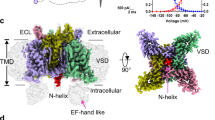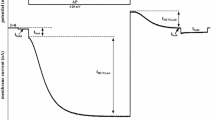Summary
Elementary Na+ currents were recorded at 19°C during 220-msec lasting step depolarizations in cell-attached and inside-out patches from cultured neonatal rat cardiocytes in order to study the modifying influence of iodate, bromate and glutaraldehyde on single cardiac Na+ channels.
Iodate (10 mmol/liter) removed Na+ inactivation and caused repetitive, burst-like channel activity after treating the cytoplasmic channel surface. In contrast to normal Na+ channels under control conditions, iodate-modified Na+ channels attain two conducting states, a short-lasting one with a voltage-independent lifetime close to 1 msec and, likewise tested between −50 and +10 mV, a long-lasting one being apparently exponentially dependent on voltage. Channel modification by bromate (10 mmol/liter) and glutaraldehyde (0.5 mmol/liter) also included the occurrence of two open states. Also, burst duration depended apparently exponentially on voltage and increased when shifting the membrane in the positive direction, but there was no evidence for two bursting states. Chemically modified Na+ channels retain an apparently normal unitary conductance (12.8±0.5 pS). Of the two substates observed, one of them is remarkable in that it is mostly attained from full-state openings and is very short living in nature; the voltage-independent lifetime was close to 2 msec. Despite removal of inactivation, open probability progressively declined during membrane depolarization. The underlying deactivation process is strongly voltage sensitive but, in contrast to slow Na+ inactivation, responds to a voltage shift in the positive direction with a retardation in kinetics. Chemically modified Na+ channels exhibit a characteristic bursting state much shorter than in DPI-modified Na+ channels, a difference not consistent with the hypothesis of common kinetic properties in noninactivating Na+ channels.
Similar content being viewed by others
References
Aldrich, R.W., Corey, D.P., Stevens, C.F. 1983. A reinterpretation of mammalian sodium channel gating based on single channel recording.Nature (London) 306:436–441
Blondel, B., Riojeu, I., Cheneval, J.P. 1971. Heart cells in culture, a simple method for increasing the portion of myoblasts.Experientia 27:356–358
Brown, A.M., Lee, K.S., Powell, T. 1981. Sodium currents in single rat heart cells.J. Physiol. (London) 318:479–500
Catterall, W.A. 1986. Voltage-dependent gating of sodium channels: Correlating structure and function.Trends Neurosci. 9:7–10
Chinn, K., Narahashi, T. 1986. Stabilization of sodium channel states by deltamethrin in mouse neuroblastoma cells.J. Physiol (London) 380:191–207
Clark, R.B., Giles, W. 1987. Sodium current in single cells from bullfrog atrium: Voltage dependence and ion transfer properties.J. Physiol. (London) 391:235–265
Colquhoun, D., Hawkes, A.G. 1983. The principles of the stochastic interpretation of ion channel mechanism.In: Single Channel Recordings. B. Sakmann and E. Neher, editors. pp. 135–176. Plenum, New York
Colquhoun, D., Sigworth, F. 1983. Fitting and statistical analysis of single channel records.In: Single Channel Recordings. B. Sakmann and E. Neher, editors. pp. 191–264. Plenum, New York
Drews, G., Rack, M. 1988. Modification of sodium and gating currents by amino group specific cross-linking and monofunctional reagents.Biophys. J. 54:383–391
Fenwick, E.M., Marty, A., Neher, E. 1982. Sodium and calcium channels in bovine chromaffin cells.J. Physiol. (London) 331:599–635
Gorin, G., Godwin, W.E. 1966. The reaction of iodate with cystine and with insulin.Biochem. Biophys. Res. Commun. 25:227–232
Hamill, O.P., Marty, A., Neher, E., Sakmann, B., Sigworth, F.J. 1981. Improved patch-clamp techniques for high resolution current recordings from cells and cell-free membrane patches.Pflüegers Arch. 391:85–100
Hille, B. 1984. Ionic channels in excitable membranes. Sinauer Associates, Sunderland, (MA)
Horn, R., Vandenberg, C.A. 1984. Statistical properties of single sodium channels.J. Gen. Physiol. 84:505–534
Huang, J.M.C., Tanguy, J., Yeh, J.Z. 1987. Removal of sodium inactivation and block of sodium channels by chloramine-T in crayfish and squid giant axons.Biophys. J. 52:155–163
Huang, L.Y.M., Moran, N., Ehrenstein, G. 1984. Gating kinetics of batrachotoxin-modified sodium channels in neuroblastoma cells determined from single-channel measurements.Biophys. J. 45:313–322
Keller, B.U., Hartshorne, R.P., Talvenheimo, J.A., Catterall, W.A., Montal, M. 1986. Sodium channels in planar lipid bilayers. Channel gating kinetics of purified sodium channels modified by batrachotoxin.J. Gen. Physiol. 88:1–23
Kirsch, G.E., Brown, A.M. 1989. Kinetic properties of single sodium channels in rat heart and rat brain.J. Gen. Physiol. 93:85–99
Kohlhardt, M., Fichtner, H., Fröbe, U. 1988. Predominance of poorly reopening single Na+ channels and lack of slow Na+ inactivation in neonatal cardiocytes.J. Membrane Biol. 103:283–291
Kohlhardt, M., Fröbe, U., Herzig, J.W. 1986. Modification of single cardiac Na+ channels by DPI 201-106.J. Membrane Biol. 89:163–172
Kohlhardt, M., Fröbe, U., Herzig, J.W. 1987. Properties of normal and noninactivating single cardiac Na+ channels.Proc. R. Soc. London B 232:71–93
Mark, G.E., Strasser, F.F. 1966. Pacemaker activity and mitosis in cultures of newborn rat heart ventricles.Exp. Cell Res. 44:217–233
Means, G.E., Feeney, R.E. 1971. Chemical Modification of Proteins. pp. 169–171. Holden-Day, San Francisco
Nagy, K. 1988. Mechanism of inactivation of single sodium channels after modifications by chloramine-T, sea anemona toxin and scorpion toxin.J. Membrane Biol. 106:29–40
Neher, E. 1983. The charge carried by single-channel currents of rat cultured muscle cells in the presence of local anaesthetics.J. Physiol. (London) 339:663–678
Noda, M., Shimizu, S., Tanabe, T., Takai, T., Kayano, T., Ikeda, T., Takahshi, H., Nakayama, H., Kanaoka, Y., Minamino, N., Kangawa, K., Matsuo, H., Raftery, M., Hirose, T., Inayama, S., Hayashida, H., Miyata, T., Numa, S. 1984. Primary structure ofElectrophorus electricus sodium channel deduced from cDNA sequence.Nature (London) 312:121–127
Nonner, W., Spalding, B.C., Hille, B. 1980. Low intracellular pH and chemical agents slow inactivation gating in sodium channels of muscle.Nature (London) 284:360–363
Oxford, G.S., Wu, C.H., Narahashi, T. 1978. Removal of inactivation in squid giant axons by N-bromoacetamide.J. Gen. Physiol. 71:227–247
Patlak, J., Horn, R. 1982. Effect of N-bromoacetamide on single sodium channel currents in excised membrane patches.J. Gen. Physiol. 79:333–351
Patlak, J., Ortiz, M. 1985. Slow currents through single sodium channels of the adult rat heart.J. Gen. Physiol. 86:89–104
Patlak, J.B., Ortiz, M., Horn, R. 1986. Open time heterogeneity during bursting of sodium channels in frog skeletal muscle.Biophys. J. 49:773–777
Quandt, F.N. 1987. Burst kinetics of sodium channels which lack fast inactivation in mouse neuroblastoma cells.J. Physiol. (London) 392:563–585
Quandt, F.N., Narahashi, T. 1982. Modification of single Na+ channels by batrachotoxin.Proc. Natl. Acad. Sci. USA 79:6732–6736
Rojas, E., Armstrong, C.M. 1971. Sodium conductance activation without inactivation in Pronase-perfused axons.Nature New Biol. 229:177–178
Scanley, B.E., Fozzard, H.A. 1987. Low conductance sodium channels in canine cardiac Purkinje cells.Biophys. J. 52:489–495
Stämpfli, R. 1974. Intraaxonal iodate inhibits sodium inactivation.Experientia 30:505–508
Tosteson, M.T., Auld, D.S., Tosteson, D.C. 1989. Voltage-gated channels formed in lipid bilayers by a positively charged segment on the Na-channel polypeptide.Proc. Natl. Acad. Sci USA 86:707–710
Ulbricht, W., Stoye-Herzog, M. 1984. Distinctly different rates of benzocaine action on sodium channels of Ranvier nodes kept open by chloramine-T and veratridine.Pfluegers Arch. 401:439–445
Author information
Authors and Affiliations
Rights and permissions
About this article
Cite this article
Kohlhardt, M., Fichtner, H. & Fröbe, U. Gating in iodate-modified single cardiac Na+ channels. J. Membrain Biol. 112, 67–78 (1989). https://doi.org/10.1007/BF01871165
Received:
Revised:
Issue Date:
DOI: https://doi.org/10.1007/BF01871165




